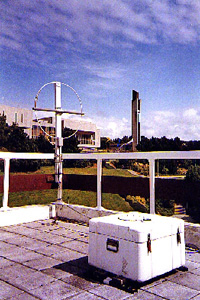SAOZ Measurements

A spectrometer of the Système D'Analyse par Observations Zénithales (SAOZ) design is currently being operated from the rooftop of the Department of Physics at the University of Wales Aberystwyth. It is a zenith sky UV-visible spectrometer which is used to retrieve mean values of total ozone and nitrogen dioxide both at sunrise and sunset on a daily basis.
SAOZ Instrument Description
The SAOZ consists of a commercial Jobin-Yvon CP200 flat field spectrometer equipped with a holographic 360 gr/mm grating and a Hamamatsu 1024 diode array uncooled detector, with a 50 micron entrance slit allowing an average resolution of the order of 1 nm in the range 300-600 nm. The spectrometer is housed in a dust- and water-proof container with a quartz window to enable measurements from the zenith sky. The instrument is driven by a PC (with Windows 95 operating system) and records and analyses the spectra in real time. Measurements are performed from sunrise to sunset until a Solar Zenith Angle (SZA) of 94. The exposure time is adjusted automatically between 0.1s to 60s in order to optimise the signal, and the spectra are added to memory during a 60s duty cycle. The dark current is measured each time the duration of exposure changes, and is then subtracted. Averages of ozone and NO2 morning and evening vertical columns are measured between 87 to 91 SZA.
Algorithm Description
After a precise wavelength alignment with the use of the Fraunhofer solar absorption lines, actual spectra are divided by a reference spectrum recorded at high sun on a clear and unpolluted day. Monotonic large trends are then removed by subtracting the same spectrum smoothed at a broad bandpass (40 nm) resulting in an atmospheric differential spectrum, in which narrow features corresponding to absorption by ozone, nitrogen dioxide, O4 (oxygen dimer), water vapour and OClO, are remaining. Slant columns are then calculated by least squares fitting between the signal and the differential cross sections of each absorber in an iterative process in which the contributions of the various species are calculated and removed sequentially. Ozone is measured in the Chappuis visible bands (450-570 nm) where the cross sections are independent of the temperature; nitrogen dioxide in 412-490 nm range; O4 in two bands (465-484 nm and 556-584 nm); and H2O in one band (440-600nm).
Expected Precision/Accuracy of Instrument
Precision given in data files, available on request. For total column, precision approximately 2 DU for ozone and 1.5 E14 mol/cm2 for NO2.
Instrument History
Installed at Aberystwyth (52.41°N, 4.06°W) March 1991.
Based at Lerwick (60°N, 1°W) from 2/11/91 - 9/5/92,
at Aberdeen (57°N, 2°W) from 8/2/94 - 3/5/94,
at Camborne (50°N, 5°W) from 9/9/94 - 23/9/94,
and at OHP (44°N, 6°E) from 8/6/96 - 21/6/96.
Original PCD 512 detector replaced in December 1992 with a NMOS 512 detector.
NMOS 512 detector replaced with NMOS 1024 detector in May 1998 at same time as changing from HP to PC control.
Related Links
- British Antarctic Survey
- European Ozone Research Coordinating Unit
- GOME Fast Delivery Service
- Information about the Ozone Layer
- Network for the Detection of Stratospheric Change (NDSC)
- TOMS Satellite - includes latest images
- UK Met.Office
- WMO Ozone Mapping Centre
SAOZ NO2 paper published in J. Env. Monitoring March 2006:
For more information email your request to Geraint Vaughan.